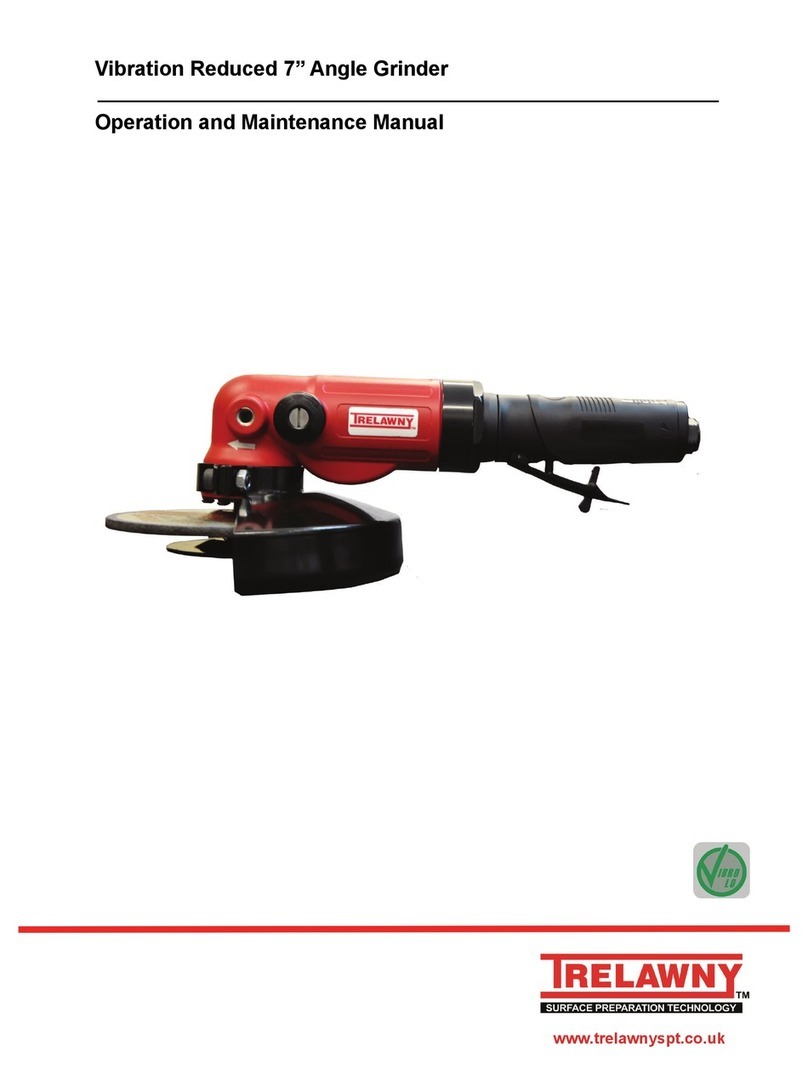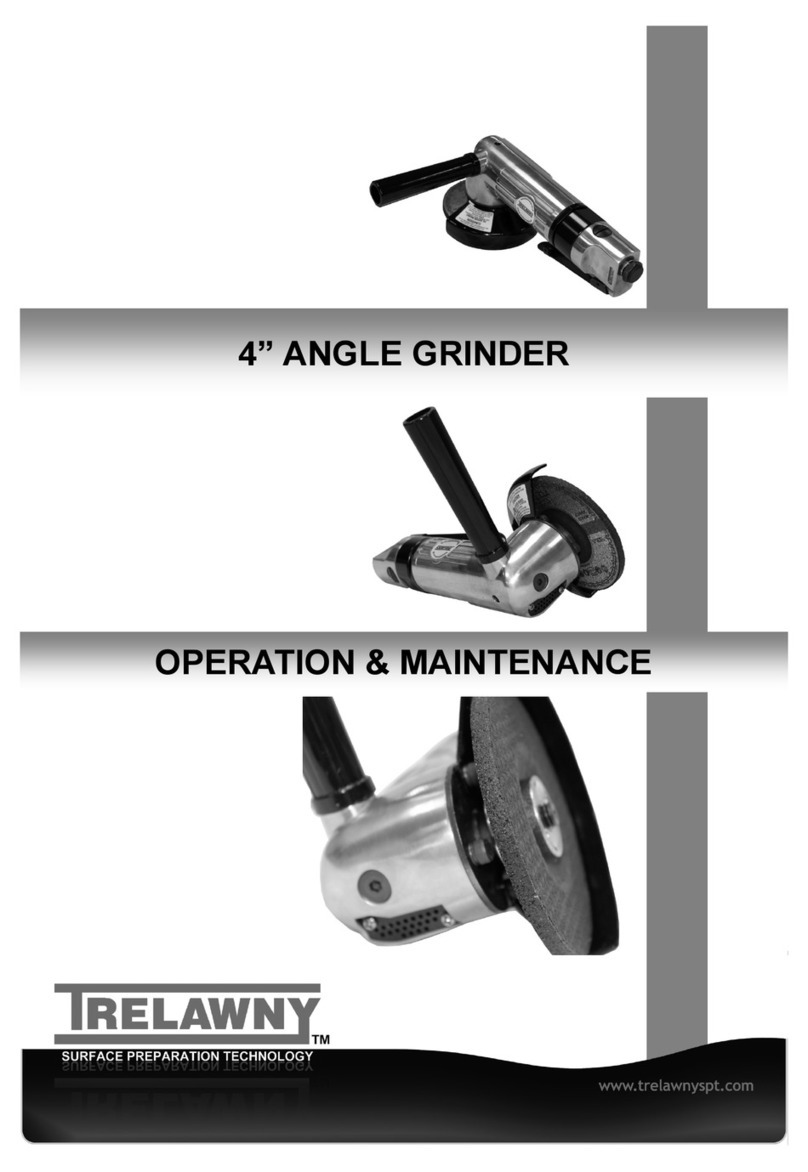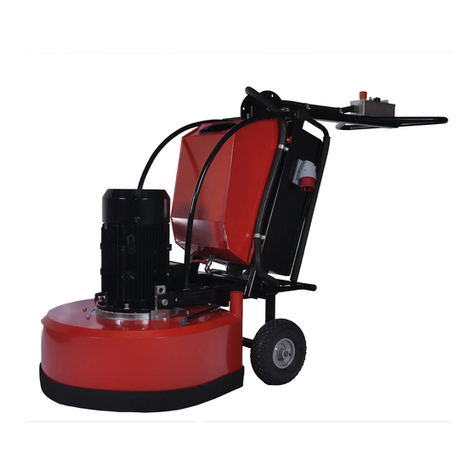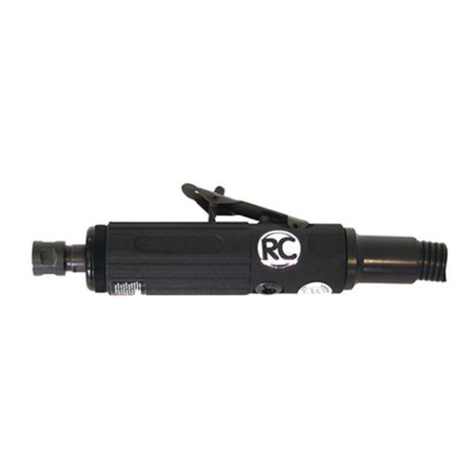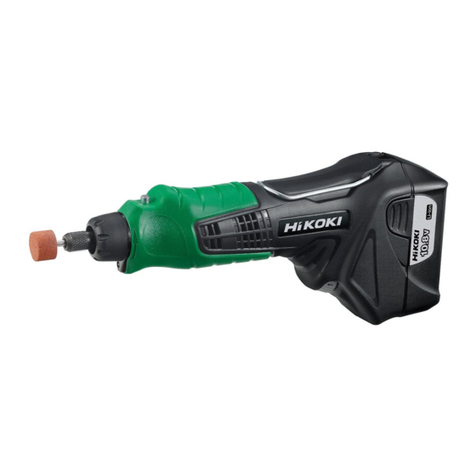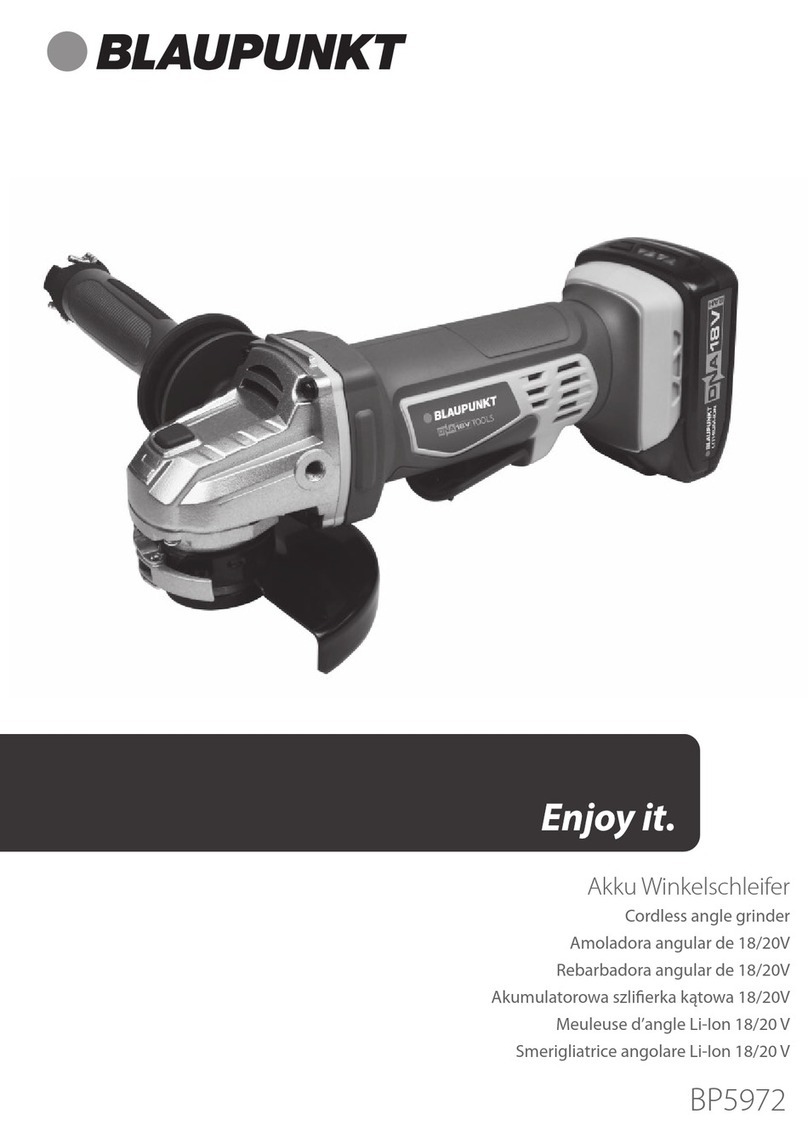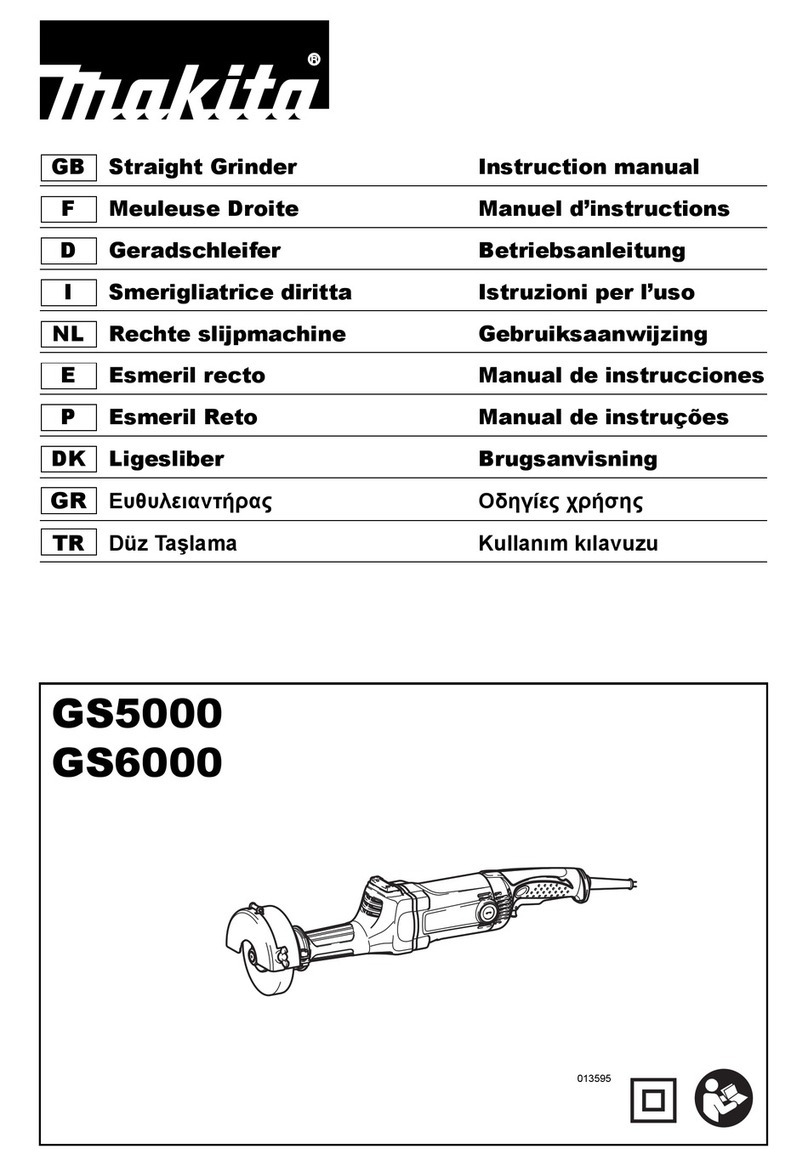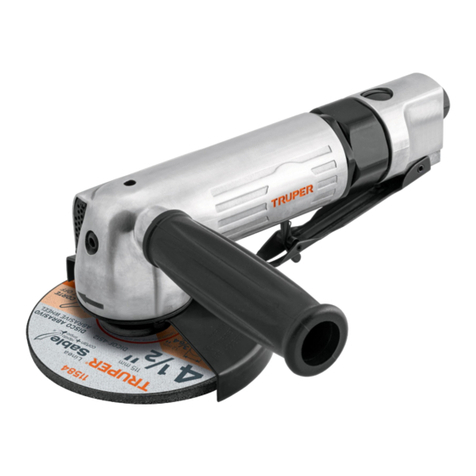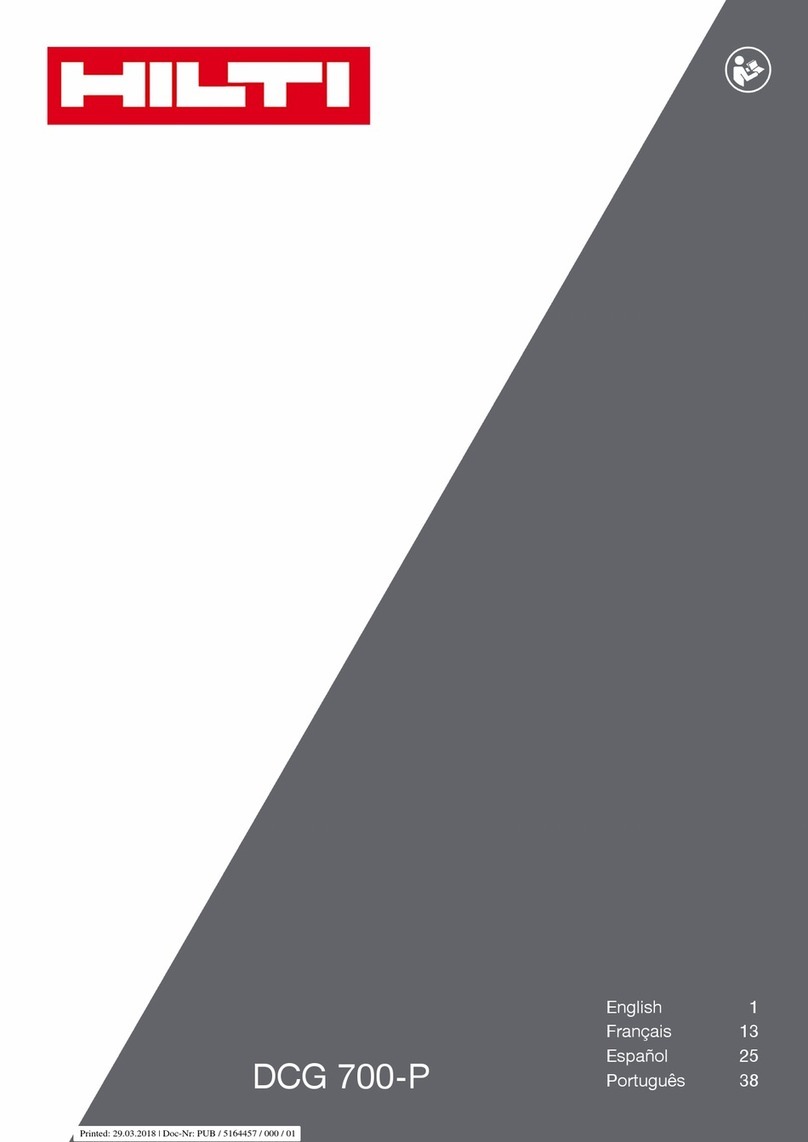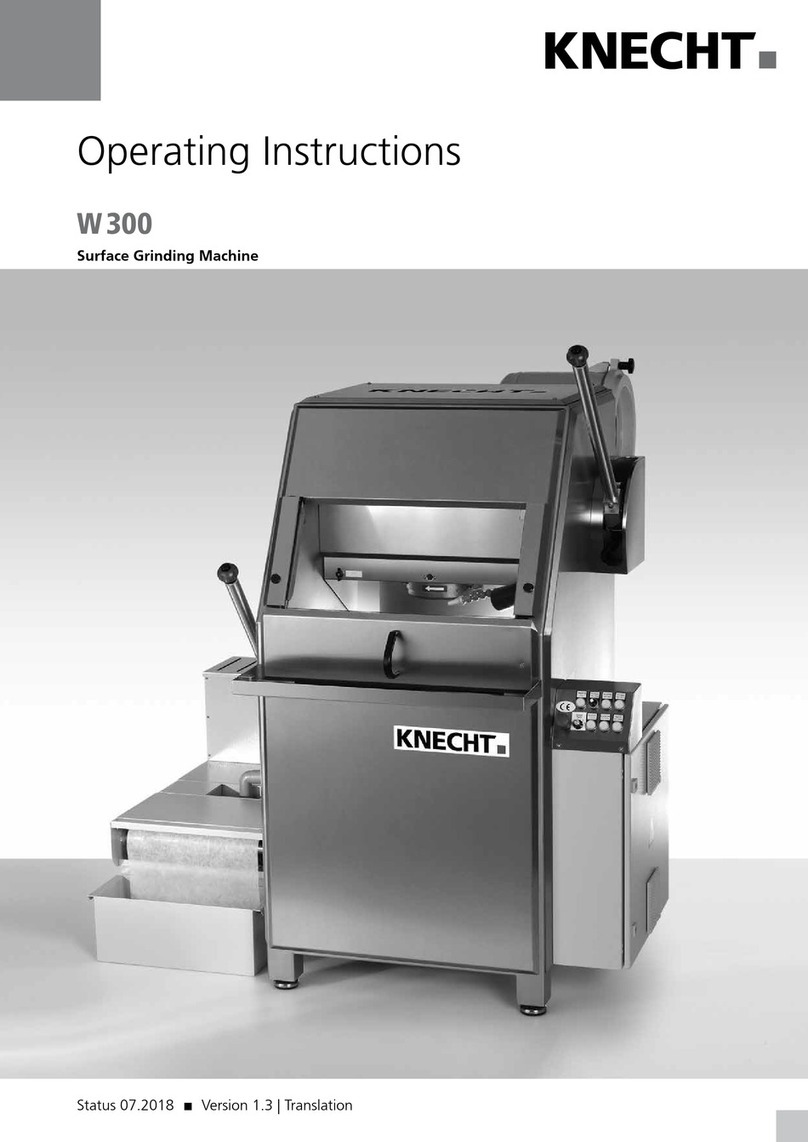Trelawny 735.7075 Troubleshooting guide

OPERATION & MAINTENANCE
7” ANGLE GRINDER

OPERATION
Foreword
Thank you for your purchase of the
TRELAWNY 7” Angle Grinder
This manual contains the necessary
maintenance information for you to
ensure proper operation and care for
this machine.
It is essential for you to read
through this manual thoroughly.
In the unlikely event that you
experience problems with your Angle
Grinder, please do not hesitate to
contact your local Trelawny dealer or
agent. We always welcome feedback
and comments from our valued
customers.
Safety Precautions
WEAR SAFETY BOOTS, FACE
MASK, SHATTERPROOF GLASSES,
HELMET, GLOVES and any other
personal protective equi pment
required for the working conditions.
Avoid loose clothing; this may become
trapped in moving parts and cause
serious injury.
A I R M O T O R S A R E N O T
ELECTRICALLY INSULATED.
ENSURE THAT HANDS and clothing
are kept away from rotating parts.
ONLY YOUR SUPERVISOR OR
A U T H O R I S E D M A I N T E N A N C E
ENGINEER should adjust the speed
control setting within the air motor;
although this has been set to the
optimum speed during manufacture,
the speed should be checked on a
daily basis.
ENSURE THAT THE WORK PLACE
IS W EL L VENTI LATED. A void
o p e r a t i n g e n g i n e - p o w e r e d
compressors in an enclosed area,
since engine exhaust gases are
poisonous.
BE AWARE, when the angle grinder is
switched off, the work head will
continue to rotate briefly.
The air supply should be lubricated. It is
strongly recommended that an air filter,
regulator, lubricator is used, this will supply
clean, lubricated air at the correct pressure
to the tool.
Details of such equipment can be obtained
from your supplier.
If such equipment is not used then the tool
should be lubricated by shutting off the air
supply to the tool, depressurising the line
by pressing the trigger on the tool.
Disconnect the air line and pour into the
air intake a teaspoonful (5ml) of a suitable
pneumatic motor lubricating oil preferably
incorporating a rust inhibitor.
Reconnect tool to air supply and run tool
slowly for a few seconds to allow air to
circulate the oil. If tool is used frequently
lubricate on daily basis and if tool starts to
slow or lose power.
Pre-Start Check (Daily)
Check all bolts and screws for tightness.
Ensure that all fittings are secure.
Check condition of hub or drum
assembly and replace flaps, cutters or
axles if required.
The air motor speed is preset at the
factory to 7,000 rpm (free running).
Always clear the air hose before
connection to the machine.
Ensure that no moisture (condensation)
is present in the air hose.
Check the security of all hoses clamps
and fittings, and that the air pressure is
correct at 90psi (6.3bar).
The air motor uses approximately 12cfm
of air.
The Maximum air pressure is 100psi
(7bar) the air consumption will increase
as the air pressure rises.
It is recommended that the compressor
is capable of supplying at least 40cfm
supply of free air (not displaced, as given
by some compressor manufactures).
In particularly cold weather it is
recommended that a proprietary anti-
freeze lubricating oil is used.
Risk of Hand-arm
Vibration injury
These tools may cause Hand-arm
Vibration Syndrome injury if their use is
not adequately managed.
We advise you to carry out a risk
assessment and to implement measures
such as; limiting exposure time [i.e.
actual trigger time, not total time at
work], job rotation, ensuring the tools are
used correctly.
Ensure the tools are maintained
according to our recommendations, and
ensuring that the operators wear
personal protective equipment [PPE]
particularly gloves and clothing to
keep them warm and dry.
Employers should consider setting up a
programme of health surveillance to
establish a benchmark for each operator
and to detect any early symptoms of
vibration injury.
We are not aware of any PPE that
provides protection against vibration
injury by attenuating vibration emissions.
See „Specifications‟ section for vibration
emission data.
Grinding Discs, Flap
Wheels & Applications
Grinding Discs
851.7050 - for use on steel.
Use of tool
This right angle grinder is designed to be
used with reinforced resin bonded
depressed centre grinding wheels that
have a permitted rotational speed in
excess of 7,000 RPM.
The tool is designed to be used for
grinding and dressing of welds, etc. but
not for cutting off.
The grinder must never be used if a
wheel guard (disc cover) item (3) is not
fitted.

OPERATION
Putting into service
Remove plastic bung from air inlet using
a pair of pliers.
Use a clean lubricated air supply that will
give a measured air pressure to the tool
of 6.3bar (90psi). It is recommended a
air filter/regulator/lubricator is used which
can be obtained from air tool supplier.
Operating
With the grinder correctly connected to
the air supply, check the speed of the
grinder with an inlet pressure of 100
psi/7.0 bar measured at the tool inlet.
Check with a calibrated tachometer.
Check that the guard is in position and
securely fixed.
Check that the grinding wheel is of correct
dimensions, is not cracked or chipped and
has a permitted speed rating higher than
the maximum permissible running speed
of the grinder which is 7,000 RPM.
Check that it is screwed tightly to the shaft
and locates the bore of the grinding wheel
on the spigot of the disc receiver and
screw on disc nut item (4) using the
spanners provided. It should be tight
enough to prevent wheel spin off when
the air supply is shut off.
When first starting the grinder with a new
or changed wheel fitted, the grinder
should first be started in a protected area,
i.e. such as under a heavy bench well
away from other persons and run for, say,
one minute.
This will provide protection if the wheel
should break because of a fault that was
not visibly detected
Always use eye protection and wear
protective gloves if there are sharp edges
in the working area.
The tool and the grinding process can
create a noise level such that ear
protectors should be worn.
If the grinding process creates a dust then
use a suitable breathing mask.
Check that the material being worked will
not cause harmful dust or fumes. If this is
so then special breathing apparatus may
be required. Seek advice before starting
work.
If the grinder vibrates when first fitting the
wheel or during use, remove from service
immediately and arrange for the fault to
be corrected before continuing to use.
Do not apply excessive pressure as this
will reduce the cutting efficiency.
Apply light loads and allow the wheel to
cut.
Handle the grinder with care.
If the grinder is dropped, carefully
examine the wheel for damage and
replace if necessary.
Start the machine as if for the first time of
fitting a wheel, i.e. under a bench.
Make sure the object to be ground is in a
firm fixed position.
Dismantling & Assembly
Instructions
This tool has an output shaft with 5/8
UNC thread shaft.
Disconnect tool from air supply.
To dismantle, insert the peg spanner (70)
into disc nut (4) and with a spanner (38)
on the flats of gear shaft (10) unscrew
disc nut (4), take off disc (49) and
unscrew disc receiver (5).
Remove cover screw (50) and nut (51)
and take off disc cover (3). Unscrew side
handle (52).
Grip the valve body (58) in a vice fitted
with soft jaws and take out head screw (2)
and screw (55) and with a suitable peg
spanner unscrew [left hand thread]
bearing screw (27).
Grip gear shaft (10) and pull out the bevel
gear drive assembly. Remove ring (12)
and support bearing (8), bevel gear (9),
wave washer (13) and key (11).
Through the small hole in body (1A) tap
out spacer (6) and bearing (7) with a small
punch.
Take out capscrew (56) to remove
exhaust deflector (57). Take out 4 off
screws (29) with lockwashers (30) and
take off valve body assembly and gasket
(48).
Pull out the motor assembly complete
with bevel drive and governor assembly
from body (1A).
To dismantle this assembly remove
retaining ring (20) and pull off bevel pinion
(17) with bearing (16).
Grip splined end of the rotor (24) carefully
so as not to damage the splines and
unscrew [left hand thread] the governor
assembly by using a spanner on the flat
sides of governor (32).
Hold front case (21) and with a non
metallic or soft metal [lead or aluminium]
hammer so as not to damage the splines,
tap rotor (24) through the front case and
bearing assembly.
Pinion (17) may be pressed out of bearing
(16) and bearing (15) tapped out of front
case (21). Take off cylinder (22) but do
not remove the 2 off pins from cylinder
(22) unless replacements are required -
note orientation of cylinder (22) to front
case (21) and rear case (26) for
reassembly. Remove 4 off rotor blades
(23) from rotor (24).
Support rear case (26) in a piece of tube
with a bore as close as possible to the
maximum diameter of the rotor and tap
the non splined end of the rotor to drive it
through the rear case and bearing
assembly. Tap out bearing (15) from rear
case (26).
To dismantle the governor assembly
unscrew adjust nut (18), remove spring
(35) and take out plunger (33) and adjust
screw (19) assembly.
These two items (33) and (19) should not
be dismantled and are only available for
spares as an assembly.
Drive out 2 off spring pins (37) and take
out 6 off pendulums (31) from governor
(32).
When removing the pendulums from the
assembly take special note of the
orientation to ensure that they are
assembled in the same way on
reassembly. This is Important.
To dismantle the valve body assembly
unscrew hose adaptor (64), drive out pin
(60) to remove lever (59).
Remove retaining ring (63) and take out
lock pin (62)and spring (61).
Unscrew valve screw (65) and take out O-
ring (66), spring (67) valve stem (68) and
O-ring (69).

TECHNICAL SPECIFICATIONS
Description 7” Air
Weight 2.9kg/6.38lbs
Spindle dia 5/8” UNC
Power requirements 12cfm@90psi (3/8””BSP inlet)
Maximum air pressure 7 bar (100psi)
No load RPM 7,000 RPM
Recommended hose bore - to a max length 10 metres 10mm (3/8”)
Vibration (AEQ)
Primary hand position (trigger position) 6.2m/s2(k)
Test method in accordance with ISO standards BS EN ISO 28927-12:2012
Noise
Noise LpA (Pressure Level) 90.0dB(A)
Test methods in accordance with Pneurop test code PN8NTC1 & ISO 3744
MAINTENANCE
For the motor make sure that the end
plates that abut the cylinder are free from
burrs and sharp edges and if necessary
lap on a flat fine grade of abrasive paper.
Press bearing (15) into rear case (26) and
support the inner race of bearing (15) and
press the non splined end of rotor (24)
into the assembly.
Tap the rotor relative to the rear case and
bearing assembly until a clearance of
approx. 0.0025” (0.065mm) is achieved
between the rotor and the rear case.
Ensure the rotor spins freely before
assembling the rest of the motor
assembly.
Reassembly
Clean all parts and examine for wear.
Use only distributor or manufacturer
supplied spare parts.
Particularly examine O-rings, bearings
and gears.
Coat all parts in a pneumatic tool
lubricating oil, one preferably containing a
rust inhibitor.
Grease bearings and gears with a
molybdenum or lithium based general
purpose grease.
Reassemble in the reverse order.
This machine has a speed controller or
governor, parts (21), (28), (42), (44), (45)
and (46).
The correct setting of this speed controller
is critical to the safety of the tool and
should only be carried out by a trained
competent person.
The speed is set by assembling the speed
controller, measuring the output spindle
gear shaft (11) speed with a calibrated
tachometer.
Adjustment to the spindle speed can be
made by rotating adjust screw (42).
The speed of the grinder running free with
an air inlet pressure of 100 psi (7 bar)
measured at air inlet (57) must not
exceed 7,000 RPM.
EXPLODED VIEW

SAFETY RULES
Safety Rules for a Grinder
1) Read all the instructions before using this tool. All operators must be fully trained in its use and aware of these safety rules.
2) Do not exceed the maximum working air pressure.
3) Use personal protective safety equipment.
5) If the tool appears to malfunction remove from use immediately and arrange for service and repair.
6) If the tool is used with a balancer or other support device ensure that it is fixed securely.
7) Always keep hands away from the working attachment fitted to the tool.
8) The tool is not electrically insulated. Never use the tool if there is any chance of it coming into contact with a live electrical
source.
9) Always when using the tool adopt a firm footing and/or position and grip the tool firmly to be able to counteract any forces
or reaction forces that may be generated whilst using the tool.
10) Use only correct spare parts. Do not improvise or make temporary repairs.
11) Do not lock, tape, wire, etc. the on/off valve in the run position. The trigger/lever etc. must always be free to return to the
„off‟ position when it is released.
12) Always shut off the air supply to the tool, and depress the trigger/lever etc. to release air from the feed hose before fitting,
adjusting or removing the working attachment.
13) Check hose and fittings regularly for wear. Replace if necessary. Do not carry the tool by its hose and ensure the hand is
remote from the on/off control when carrying the tool with the air supply connected.
14) Take care against entanglement of moving parts of the tool with clothing, ties, hair, cleaning rags, etc. This will cause the
body to be drawn towards the tool and can be very dangerous.
15) Users will adopt safe working practices and observe all relevant legal requirements when installing, using or maintaining
the tool.
16) Do not install the tool unless an easily accessible and easily operable on/off valve is incorporated in the air supply.
17) Take care that the tool exhaust air does not cause a problem or blows on another person.
18) Never lay a tool down unless the working attachment has stopped moving.
19) A grinding wheel should only be fitted by a competent person trained to do so. The wheel must be of the correct size and
speed rating.
20) Check the speed of the grinder at least once per week, if it is in regular use, with an accurate tachometer.
21) The tool must only be used with the grinding wheels as set out in section “Use of the Tool” and shown on parts list. Never
fit any other device.
22) Carry out the instructions as set out in “Putting into Service”.
23) Many countries have local or national rules re the use and fitting of grinding wheels. Make sure such rules are observed.
24) Use a barrier to prevent sparks causing a hazard to the operator, any other person or anything within the vicinity of the
sparks.
25) If a wheel guard becomes damaged or has withstood a wheel breakage, the guard must be changed.
26) Do not use chipped or cracked grinding wheels.
27) Always wear impact resistant eye protection.
28) Use only the disc plates, Items (4) and (5) provided with the grinder for locating and clamping the wheel. Never use
substitutes. Use the paper blotter fixed to the wheel as this ensures even tightness when the wheel is secured.
29) Tighten the wheel plates sufficiently to prevent wheel spin off when the grinder is turned off. Do not tighten excessively as
this may crack the wheel.
30) The noise from the tool or the process noise of the grinding operation may be such that hearing protection should be
worn.
31) Avoid inhaling dust from the grinding process. Wearing of a breathing mask is recommended. Grinder certain materials
may mean that special breathing precautions are necessary. Seek advice before using the tool.
32) Always ensure that the work piece is firmly supported so that it cannot move during the grinding process.
33) If the grinder is dropped do not use unless the wheel is first checked for damage by a competent person.
34) When not in use the grinder should be stored in a safe place where it will not be damaged. If a tool has not been used for
a period of time check the tool as for the first time of using.
35) Be aware that if the grinding process causes high vibration, special precautions should be taken.
36) The operator should be aware that the grinding wheel will continue to rotate after the power supply has been shut off. This
could cause a hazard.
37) Always store grinding wheels in accordance with the manufacturer‟s instructions.
38) Check frequently that the spindle thread has not become damaged or worn.
39) Always ensure that the grinding wheel has a higher permissible running speed to the speed of the grinder.

PARTS LIST
Trelawny tools are thoroughly tested under specified conditions in accordance with applicable internationally recognised standards. When a tool is used on site the
conditions may not be the same as those used in our tests
Trelawny Surface Preparation Technology operates a policy of continuous product development and refinement and therefore reserves the right to change technical
specifications and product designs without giving prior notice.
© Copyright 2013, Trelawny SPT Limited, CV31 1XT. UK All rights reserved. Any unauthorised use or copying of the contents or part thereof is prohibited. This applies to
trademarks, model denominations, part numbers and drawings.
Use only genuine Trelawny spares.
The use of non-Trelawny spare parts invalidates the warranty.
SURFACE PREPARATION TECHNOLOGY
Trelawny SPT Limited
Trelawny House, 13 Highdown Road, Sydenham Industrial Estate,
Leamington Spa, Warwickshire, CV31 1XT, United Kingdom
Telephone: +44 (0)1926 883781 Fax: +44 (0)1926 450352 Email: sales@trelawny.co.uk
General Industry Website: www.trelawnyspt.com
Dedicated Marine Website: www.trelawny-marine.com
© TSPT UK 2013 Part No: 735.7075 issue1
Ref Part No Description
1 370.900304 Body
2 370.732344 Head screw
3 370.900305 Disc cover
4 370.900658 Disc nut (Threaded)
5 370.900657 Disc receiver (Threaded)
6 370.900308 Spacer
7 370.900309 Ball bearing
8 370.900310 Ball bearing
9 370.900311 Bevel gear
10 370.900656 Gear shaft (Threaded)
11 370.900313 Key
12 370.729290 Retaining ring
13 370.732919 Wave washer
15 370.1005478 Ball bearing (2)
16 370.900314 Ball bearing
17 370.900315 Bevel pinion
18 370.900316 Adjust nut
19 370.900317 Adjust screw
20 370.900328 Retaining ring
21 370.900318 Front case
22 370.900319 Cylinder
23 307.900320 Rotor blade (4)
24 370.900321 Rotor
25 370.900058 Cylinder pin (2)
26 370.900322 Rear case
27 370.900323 Bearing screw
29 370.900325 Screw (4)
30 370.729035 Washer (4)
31 370.900326 Pendulum
Ref Part No Description
32 370.900327 Governor
33 370.900328 Plunger
35 370.900329 Spring
37 370.900330 Pin (2)
38 370.1010911 Spanner
39 370.900331 Allen wrench
48 370.900337 Gasket
49 370.900338 Disc
50 370.900339 Cover screw
51 370.900340 Nut
52 370.729284 Dead handle
55 370.900342 Screw
56 370.900343 Cap screw
57 370.900344 Exhaust deflector
58 370.900345 Valve body
59 370.900346 Lever
60 370.900347 Pin
61 370.900348 Lock spring
62 370.900349 Lock pin
63 370.900350 Retaining ring
64 370.900351 Hose adapter
65 370.732152 Valve screw
66 370.729263 O‟Ring
67 370.732154 Valve spring
68 370.900352 Valve stem
69 370.1008127 O‟Ring
70 370.900877 Spanner
Table of contents
Other Trelawny Grinder manuals
